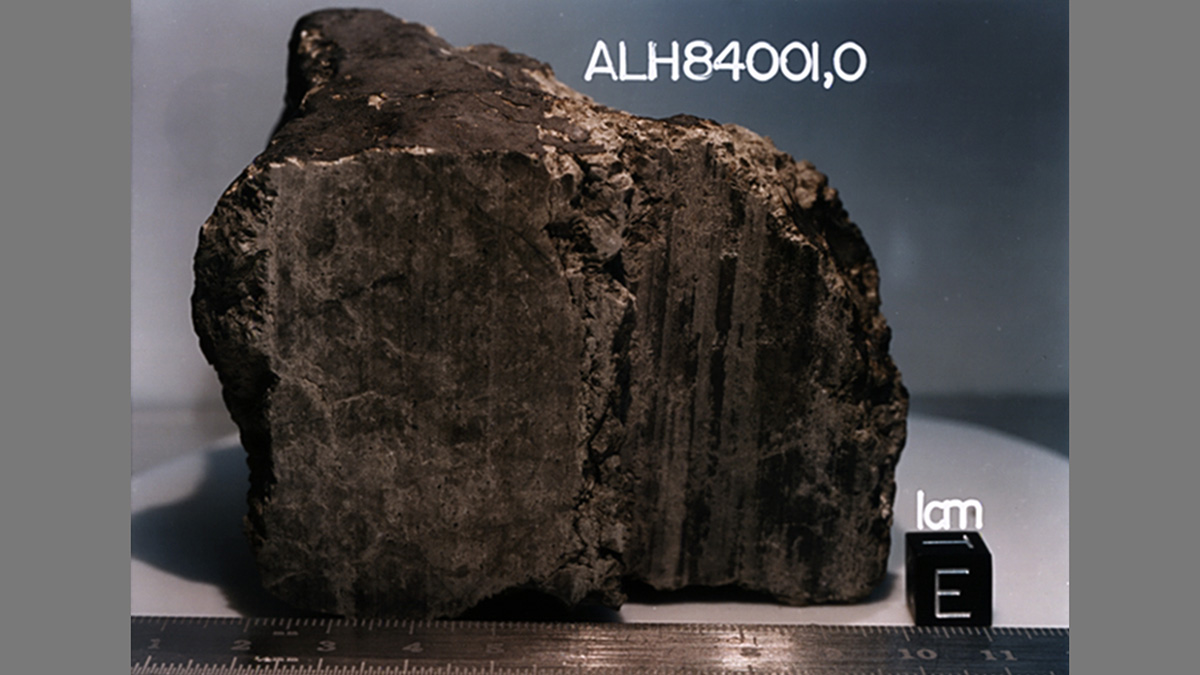Numerous stories have put Martians at the forefront of science fiction, but we can thank one 4-billion-year-old rock for placing life on Mars into the realm of serious, scientific discourse. That rock is the meteorite Allan Hills 84001 (ALH84001).
When scientists found evidence of organic molecules in ALH84001, some asserted that these remnants were indications of past life on Mars. This hypothesis drew intense skepticism, with many scientists identifying the molecules as contamination from Earth. Others maintained that a portion of the molecules—the meteorite’s polycyclic aromatic hydrocarbons (PAHs)—was Martian, whereas others found similar PAHs on Earth. Many scientists argued that abiotic processes, not life itself, could easily account for PAHs and other organics in the meteorite.
Nearly 30 years after the meteorite’s discovery, ALH84001’s organic molecules still fuel scientific inquiry. A new study, led by astrobiologist Andrew Steele at the Carnegie Institution for Science, inferred the geochemical environment of early Mars and the origins of ALH84001’s organics. The research was published earlier this month in Science.
Serpentinization and Primordial Soup
Steele’s team found evidence supporting the idea that the organics inside ALH84001 are from Mars. When measuring the hydrogen isotope ratios of the organics and weathered minerals, for instance, the team found that the ratio of heavy to light hydrogen matched that measured in water found on Mars’s crust.

When examining the mineral composition of ALH84001, Steele’s team found minerals similar to serpentine and talc on Earth. Such minerals are products of a process called serpentinization, which happens when ultramafic rocks react with water. This process results in heat and hydrogen gas, which can then reduce inorganic carbon (such as carbon dioxide and carbon monoxide) to methane and other organic molecules.
The study showed that “Mars can undertake the chemistry that eventually led to life.”
From these data, Steele’s team hypothesized that serpentinization occurred in Mars’s past and likely led to the synthesis of the organic molecules in ALH84001. The study showed that “Mars can undertake the chemistry that eventually led to life,” he said. “What we found in the meteorite is a cache of nonlife-synthesized material made [on Mars] that could contribute to a potential Martian primordial soup.”
“I think [the study] very nicely…shows evidence of serpentinization as a process to create the minerals in the rock,” said Jennifer Glass, an astrobiologist and biogeochemist at the Georgia Institute of Technology not involved in the research.
Analogues on Earth
This evidence of serpentinization opens new doors to the possibility of Mars having once been habitable. Around 4 billion years ago, Mars’s geochemical environment may have resembled the conditions of Earth around the time life arose.
In fact, hydrothermal serpentinizing environments have been proposed as the birthplace of Earth’s first life-forms. The hypothesis is that “the origin of life started as a complex set of chemical reactions that took place at hydrothermal vents,” explained Luther Beegle, a physicist turned astrobiologist at NASA’s Jet Propulsion Laboratory who was not involved in the study. Steele and colleagues’ study “shows that there is the possibility of serpentinization happening long enough to generate enough organic material so that life could have conceivably originated [on Mars].”
The study presented compelling evidence that may hint at how life could have feasibly started on Mars from abiotic processes.
Jeffrey Seewald, a geochemist at Woods Hole Oceanographic Institution who was not involved in the research, agreed. “To me, [this finding] is a particularly important contribution [of the study]…. Fluid-rock reactions, especially serpentinization, can create habitable environments by providing a source of chemical energy that can be used by microorganisms.”
The study presented compelling evidence that may hint at how life could have feasibly started on Mars from abiotic processes. But the research does not solely teach us about other worlds, said Steele; it also supports some ideas about the evolution of life here on Earth. The processes that may have contributed to organic molecules on Mars may have also been present on Earth. The study is “not just about ‘Is life out there?’ and ‘Are we alone?’ It’s also about ‘Where did we come from?’”
—Derek Smith (@djsmitty156), Science Writer

